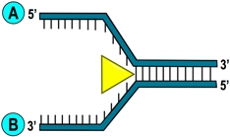In this video, we're going to introduce the leading and lagging DNA strands. And so it turns out that upon separation of DNA during DNA replication, at each replication fork, there are going to be 2 single-stranded DNA molecules. The first one will be the leading DNA strand, and the second one will be the lagging DNA strand. Now the leading DNA strand is going to be built with continuous DNA replication in the same direction as the replication fork movement. And because the leading DNA strand is built in the same direction as the replication fork movement, it only requires just one single RNA primer, and so that requirement for one single RNA primer is going to be associated with the leading strand. Now, the lagging DNA strand, on the other hand, is not built with continuous replication. Instead, the lagging DNA strand is going to be built with discontinuous replication in the opposite direction of the replication fork movement. And because it's built in the opposite direction of the replication fork movement, the lagging strand is replicated in multiple small segments that are called Okazaki fragments, and these Okazaki fragments are named after the Japanese scientist whose last name was Okazaki. And each of these small segments, each of these Okazaki fragments, each requires an RNA primer to be built. And so, the lagging DNA strand requires multiple RNA primers and, again the leading strand only requires 1 RNA primer. Now these multiple small segments in the lagging DNA strand, these Okazaki fragments, are eventually going to be covalently annealed to each other by an enzyme called DNA ligase.
And, if we take a look at our image down below, we can better distinguish between the leading and lagging DNA strands. And so, notice that here what we're showing you is a replication bubble with 2 forks. We have one replication fork over here on the left and another replication fork over here on the right. And so, you can also see the origin of replication here, which is, the sequence of DNA, where DNA replication begins. Now, at each of these replication forks, notice that there is a leading strand, which is going to be built in the same direction as the replication fork movement, and there's also going to be a lagging strand, which is built in the opposite direction of the replication fork movement. And so recall that this replication fork here is moving in this direction to the left, and this yellow background, is moving and being built in the same direction as the replication fork movement. And that also applies for this leading strand over here being built in the same direction as the replication fork movement. But the lagging strand, once again, which is highlighted with a greenish background, is being built in the opposite direction of the replication fork movement, and that goes again over here as well, being built in the opposite direction of the replication fork movement. And so, the reason that the lagging strand needs to be built in these small segments called Okazaki fragments is because of the limitations of DNA polymerase and DNA polymerase needing to build in the 5 prime to 3 prime direction. And so you can see that these Okazaki fragments are being labeled as so, and there are multiple RNA primers required for the lagging strands, whereas the leading strands, once again, only require one RNA primer. Now ultimately, remember that these RNA primers are going to be replaced with DNA. And, also these fragments of, these Okazaki fragments are going to be covalently annealed to each other with another enzyme called DNA ligase.
This here is going to conclude our introduction to the leading and lagging DNA strands, and we'll be able to get some practice applying the concepts that we've talked about here as we move forward in our course. So I'll see you all in our next video.


